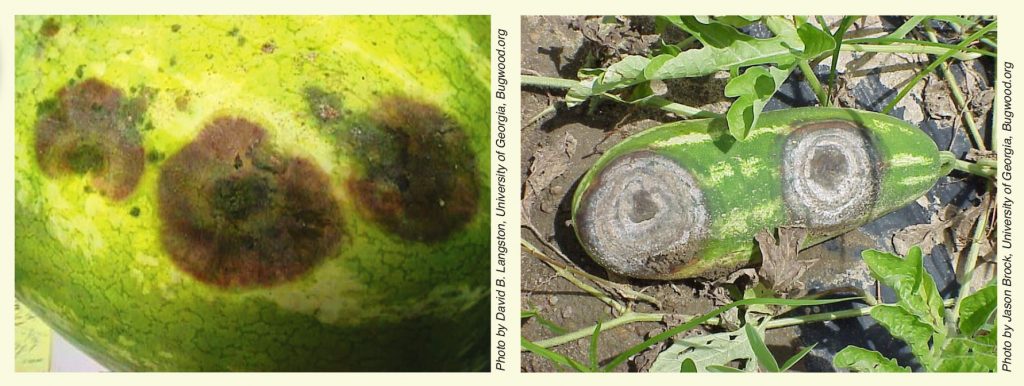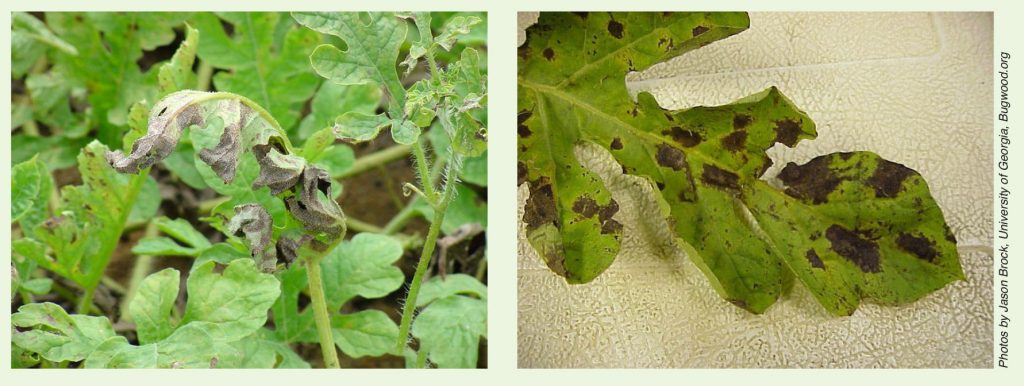
1: Photo by David B. Langston, University of Georgia, Bugwood.org
2: Photo by Jason Brock, University of Georgia, Bugwood.org
By Bhabesh Dutta
Phytophthora fruit rot has been a concern for watermelon growers not only in Georgia but also in other states that grow watermelon. No single measure has been shown to suppress the disease consistently and effectively, especially when environmental conditions are favorable for disease development.
Compared to other watermelon diseases, this disease is difficult to manage and strictly requires an integrated management program. Unlike on other cucurbit hosts (squash and cucumber, for example), phytophthora symptoms often appear on fruit and not on foliage. However, research indicates that all growth stages and plant parts are susceptible to infection.
In watermelon, fruit symptoms are quite common. Some of the common symptoms that can be observed on fruits are irregular to round, water-soaked lesions that become brown. As the disease progresses, concentric rings of pathogen sporulation may appear within a lesion.
Lesions can appear on the upper and/or lower surfaces (contact with the soil) of fruit. As the pathogen is soilborne, symptoms on the lower surface are quite common. Symptoms on the upper surface are presumed to be related to the dispersal/spread of the pathogen from contaminated soil. Under favorable conditions, complete rotting of fruit is common.
Phytophthora capsici can survive in soil or in host plant debris by means of thick-walled spores (oospores). Researchers have associated irrigation from contaminated pond water with P. capsici outbreaks in watermelon and other vegetable crops in Georgia.
The pathogen has two mating types (A1 and A2). Both mating types are necessary for oospore production. Presence of both mating types in vegetable fields is not uncommon in Georgia, which makes management more difficult. Spread of the pathogen is aided by zoospores, which are asexual spores that can swim in free moisture in the soil or on the plant surface and can infect the host. Zoospores are formed in specialized saclike structures called “sporangia” that can also spread by wind-blown rain and be carried through water.
Resistant watermelon varieties are not available. As a cultural control, it is recommended not to use retention pond water for irrigating watermelon crops. It is also advised to have good drainage in watermelon fields, which is sometimes difficult to achieve.
A preventive fungicide program is the key to get ahead with this disease. A fungicide program comprised of Presidio, Orondis Gold, Revus and Elumin may help.

Photos by Jason Brock, University of Georgia, Bugwood.org
Downy mildew has been a sporadic issue in watermelon as its incidence varies from year to year in Georgia. Unlike classical angular leaf spot symptoms that are observed in cucumber, symptoms on watermelon can be difficult to diagnose. Symptoms may start as irregular yellowish to brown spots that gradually become necrotic and often appear on upper surfaces of leaves. Lesions are often visible near the crown. As the disease progresses, necrotic lesions may appear on both sides of the leaf.
This disease can spread rapidly, aided by high humidity and wind-driven rain. Severe defoliation can be seen if timely management practices are not employed. Fruit rot due to sun scalding soon follows.
Resistant varieties are not commercially available. Crop rotation is impractical as the inoculum doesn’t survive locally in Georgia and arrives from Florida via wind current or any kind of weather events.
A preventative fungicide program is the key to get ahead with this disease. A fungicide program comprised of Ranman, Orondis Ultra, Revus and Elumin may help. Chlorothalonil (Bravo) can be used as a protectant until fruit set.









